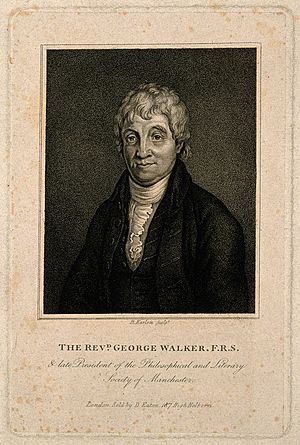George Walker (mathematician) facts for kids
George Walker (born around 1734 – died 1807) was a very talented English Dissenter. This means he was a Christian who didn't follow the official Church of England. He was known as a brilliant mathematician, a theologian (someone who studies religion), a member of the important Royal Society, and a strong activist who worked for change.
Contents
George Walker's Early Life and Learning
George Walker was born in Newcastle-on-Tyne, England, around 1734. When he was about ten, he went to live with his uncle, Thomas Walker, who was a minister. George went to Durham School, which was a well-known school at the time.
In 1749, when he was about fifteen, George went to a special school called a dissenting academy in Kendal. These schools were for students who didn't belong to the Church of England. Here, he met his good friend, John Manning. Later, he studied at Edinburgh University and Glasgow University. He focused on mathematics and also learned from famous thinkers like Adam Smith.
Becoming a Minister and a Writer
After finishing his studies in 1754, George Walker preached sometimes in Newcastle and Leeds. In 1757, he became a minister in Durham, where his uncle had also been a minister.
While in Durham, he started writing a math book called 'Doctrine of the Sphere'. He also wrote for a magazine called the Ladies' Diary. In 1762, he moved to Filby, Norfolk, and also helped a minister in Great Yarmouth. He continued his math studies, working on a book about conic sections.
Because of his smart work, he was chosen to be a Fellow of the Royal Society. This is a very respected group for important scientists and thinkers. In 1772, he became a math teacher at Warrington Academy. He worked hard to prepare his 'Doctrine of the Sphere' book for publishing, even cutting out all the pictures himself! The book came out in 1775.
Leading Change in Nottingham
In 1774, George Walker moved to Nottingham and became a minister at High Pavement Chapel. He stayed there for 24 years. During this time, he became a powerful speaker and a leader in his community. He helped unite his church, and he started a charity school in 1788.
Nottingham was a place where people had strong political ideas, and George Walker was at the front of many movements. He gave speeches and helped write official requests from the town. He supported the independence of the United States and pushed for changes in how the government worked. Even famous politicians like Edmund Burke praised his efforts.
From 1787, he led a group of Dissenters who wanted to get rid of the Test Acts. These were laws that limited the rights of people who weren't part of the Church of England. His book, Dissenters' Plea, was considered one of the best writings on the topic. He was also one of the first people to speak out against the slave trade. In 1794, he published his book on conic sections while also fighting against laws that tried to stop people from expressing their opinions.
Later Years and Legacy
In 1798, George Walker became a professor of theology at Manchester College. He taught many subjects, including classics and mathematics. He also helped lead a church in Failsworth. He retired from the college in 1803.
He stayed in the Manchester area and was elected president of the Manchester Literary and Philosophical Society, a group for people interested in science and ideas. In 1805, he moved to Wavertree, near Liverpool.
George Walker died in London on April 21, 1807, and was buried in Bunhill Fields.
George Walker's Published Works
George Walker wrote many important works, especially on mathematics and religion.
- His main mathematical books were 'Doctrine of the Sphere' (1775) and his treatise on conic sections (1794).
- He also published:
- 'Sermons,' in 1790 (two volumes).
- After he passed away, more of his works were published:
- 'Sermons,' in 1808 (four volumes).
- 'Essays ... prefixed ... Life of the Author,' in 1809 (two volumes).
George Walker's Family
George Walker married in 1772. He and his wife had two children:
- A son, also named George Walker, who later wrote a book about his father.
- A daughter, Sarah, who married George Cayley in 1795.


